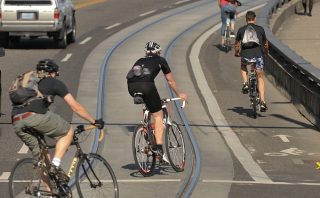
(Photos: J.Maus/BikePortland)
In the city with North America’s largest streetcar system, on-street rails almost rival automobiles as a factor in collisions that injure people on bikes.
That’s one major finding in the first academic study in North America dedicated specifically to the danger of streetcar tracks to people biking.
Among bike-related injuries in Toronto that resulted in emergency-room trips, the study found, 32 percent directly involved streetcar tracks and more than half happened on streets with streetcar tracks. And in what lead author Kay Teschke described as “a surprise to us,” 67 percent of track-related injuries happen away from intersections.
“Streetcar tracks and people on bicycles are a bad mix; they need to be separated.”
— Dan Bower, Portland Streetcar
Teschke is a professor at the University of British Columbia. Her team’s previous work with this data set (gathered from interviews with people injured at Toronto and Vancouver BC hospitals) has been a major force behind the spread of protected bike lanes in North America.
“There are so many cities building streetcar and light rail these days,” Teschke said in an email Wednesday. “It is important to learn from the Toronto situation.”
Portland is among those cities. Today, its 7-mile system has only one-eighth the length of Toronto’s. But The Oregonian reported last month on its continuing plans to expand the streetcar system on Northeast Sandy, Northeast MLK, Northeast Broadway or Southwest Macadam, overlapping with bus lines there.
Dan Bower, executive director of Portland Streetcar and the former head of Portland’s active transportation division, said in an email Wednesday that the study confirms his conviction that “streetcar tracks and people on bicycles are a bad mix; they need to be separated.”
When new streetcar spurs include good bike infrastructure like the raised protected bike lane on Southwest Moody, Bower said, streetcar projects improve biking safety.
“I think you would be hard pressed to find anything designed after 2001 to be fundamentally flawed from a cycling perspective, with one major exception of NW 10th/Lovejoy, which, importantly, led to the building of the NW Johnson and NW Marshall St. Greenways,” Bower wrote.
Bike lanes cut track-injury odds by 66 to 85 percent
Other findings from the UBC study, which was published Friday as an “open peer review” piece in Bio Med Central Public Health:
• The more often you bike, the less susceptible you are to tracks. Every additional 100 bike trips per year cut the odds of a track-related injury by one-third.
• Virtually all injuries of people who are making left turns on bikes were track-related.
• Painted bike lanes greatly reduce the odds of streetcar track injuries. Having a painted bike lane on a major street with parked cars cut the odds of a track-related injury by 85 percent; having one on a street without parked cars does so by 66 percent.
• Independently of biking frequency, women biking have double the odds of a track-related injury compared to men.
• 54 percent of the bike types “commonly sold” in Toronto bike shops have tires narrower than the 34.5 mm flangeways in that city’s streetcar tracks. (Portland’s flangeways are 44.45 mm, Bower said. Based on Teschke’s data, the overwhelming majority of common bike types likely have tires narrower than flangeways here.)
Advertisement
I asked Teschke if she had any thoughts on the gender disparity.
“Data from other studies show that women on average ride slower than men,” she said. “Usually that is a safety benefit, but perhaps a detriment when riding over tracks.”
Streetcar director: ‘Fundamental issue’ is lack of good bike lanes, not presence of tracks
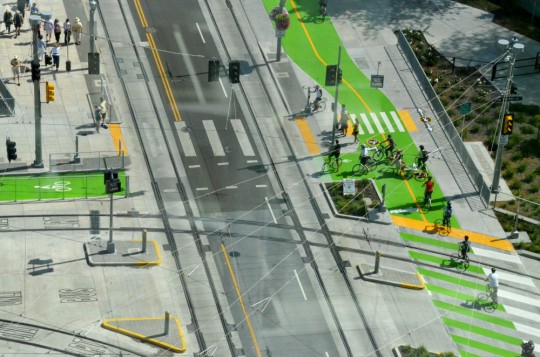
(Photo: M.Andersen)
As for the left-turn issue and the huge percentage of track-related injuries that happen mid-block, Teschke sees them as signs that streets with streetcars need clearly separated lanes and paths for bikes.
“Tracks don’t seem like a good place to perform ‘vehicular cycling’ left turns,” Teschke said, adding: “We didn’t see any non-intersection crashes on streets with dedicated streetcar rights of way.”
Bower said he’s taken two spills on streetcar tracks on his own bicycle, but noted that Toronto’s tracks were built “many, many years ago.” The “fundamental issue” with North American streetcars, he argued, is “the lack of proper bicycle facilities.”
“Streetcar has been a very active partner in trying to make the situation better here in Portland and we are constantly being asked by our peers across the country about lessons learned, which you will see applied,” Bower said. “In my role as executive director I try to be as active as possible in moving important bike projects forward because in my mind that is the best long-term solution for this issue.”
— Michael Andersen, (503) 333-7824 – michael@bikeportland.org
Our work is supported by subscribers. Please become one today.

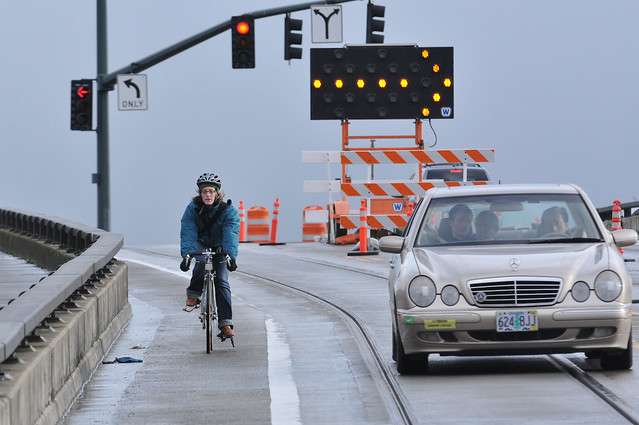
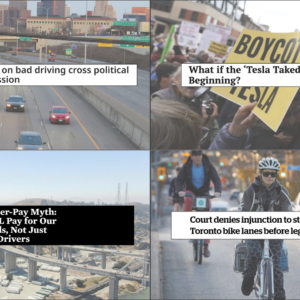
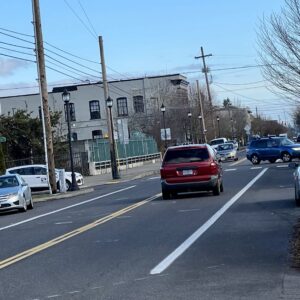

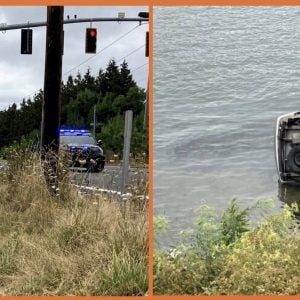
Thanks for reading.
BikePortland has served this community with independent community journalism since 2005. We rely on subscriptions from readers like you to survive. Your financial support is vital in keeping this valuable resource alive and well.
Please subscribe today to strengthen and expand our work.
I crashed on streetcar tracks once. It was a rainy day and there was a delivery vehicle blocking the bike lane. I was riding a mountain bike, so I had assumed that my tires would not get stuck in the tracks.
Unfortunately, I was incorrect and I got caught in the tracks and went over the handlebars. Fortunately, the car that was in the lane was able to stop in time, but had they been speeding or driving recklessly (like I’ve seen countless times), I would be dead.
Good piece. With additional rail-base transit, Seattle also has more injuries from cyclists encountering tracks.
Toronto is horrible for street car tracks.
The link below will show what some of these intersections are like. Streetcars just don’t follow one road or the other they make left and right turns. Almost impossible to cross perpendicularly even if you are riding straight across an intersection. Very easy to hook your wheel between the roadway and the rail and being forced to follow the track.
https://www.google.com/maps/search/streetcar/@43.645478,-79.3951716,42m/data=!3m1!1e3
As for the potential gender effect on injury rates mentioned in the article (I took a brief read of the study report), I wonder if it is a reflection of any of these factors not described:
1) lack of weight (mass) allowing heavier riders to power through road irregularities (similar to speed);
2) lack of upper body strength needed to hold a line steady or fight wheel suck;
3) a reflection of absence of more aggressive riding manoeuvres sometime necessary in traffic to weave / cross tracks at an oblique angle necessary to change lanes / make a turn; or
4) poor frame/ wheel sizing for rider of shorter stature (affects both adult sexes, though typically greater for women).
PS. I found it also interesting that the author reports tied the outcomes to “measures concordant with a Vision Zero standard”…showing the growing importance of grounding policy and infrastructure decisions to VZ outcomes.
Seems like even a 50mm tire might still fit into a 45mm flangeway. And then there’s the rain. But really I wonder whether there would be as many track-related crashes absent the constant threat and distraction of reckless auto traffic.
Could the tracks be redesigned to have narrower flageways?
Probably not, unless we want streetcars derailing periodically.
Slow down! It’s not a race out there people!
…or will bikes [aka rider buying choices] in streetcar cities evolve back to the early 20th century bike frame geometry: relaxed head tube angle, longer wheel base, ‘sit up and beg’ riding posture, and wider tires?
Pennyfarthing fatbike?
Or will we stop building worthless streetcar? I haven’t been tracking ridership lately, but have the impression it’s a boondoggle that is far from pulling its weight.
Depends on whether you’re counting transit rides per dollar spent (awful compared to buses) or infill development per dollar spent:
http://bikeportland.org/2014/08/06/case-streetcar-pro-bike-infrastructure-109840
And another question is whether it would be possible to get the infill without the streetcar just by zoning as if you were going to put in a streetcar:
http://www.citylab.com/housing/2013/06/transit-might-not-be-essential-transit-oriented-development/5851/
Do you include operation costs, which, I understand, are significantly higher for buses?
No matter the vehicle size, transit operations costs are mostly the driver and the driver’s bosses and dispatchers. So operating costs per vehicle are within the same magnitude whether it’s MAX, streetcar or bus.
Bus operations *per rider in a crowded vehicle* are way higher for bus than for MAX because MAX holds a lot more people than a bus. Streetcar capacity is in between MAX and bus.
For a well-used streetcar line like the Portland westside’s, the operations cost per trip are probably going to be less than bus trips until you start to calculate how much more frequent the bus line would be if you still had all the money you just spent laying streetcar tracks.
Sadly transit budgets don’t work that way, but only because federal policy is dumb.
On the other hand, none of that includes bus damage to pavement, which gets hidden in the city maintenance budget. I’m not sure what bus operations costs would look like if you factored that in.
I proposed a urathane contoured filler for the flangeways to an engineer at Trimet about 10 years ago and he kind of poopooed the idea. He started thinking about it 2 months later after he endoes twice in one week and so did his wife on tracks.
The flange cover would open, by weight/mass when the rail wheel went through but would return so a narrow bicycle wheel would not press into the groove that is filled. Unfortunately the urathane manufacturer is no longer alive. There are others that can do the job. BTW The particular urathane compound is impervious to sunlight and is available in bright colors including green and yellow.
What was the estimated cost per mile, and estimated useful life? I know they would wear out after some amount of time.
At that time it was about $1.10 a foot. It would only be used in high density (bicycle) crossings where the bike lane was narrowed down and bicycles had a tendency to be captured by the flange IE… like the Lovejoy ramp. The material usually lasts from 6 to 8 times as long as rubber compounds that are used for the same purpose. See Vimeo.
https://vimeo.com/16078737
Perhaps people, knowing full well there are tracks out there, should pay more attention to awareness and maneuvering abilities. Motorcyclists have known for decades to approach railroad tracks with caution so the don’t lay down their bike.
Or, perhaps people, knowing full well there are cyclists out there, should not design their freakin’ streetcar systems in a way that will, predictably, maim and kill people.
This situation was entirely predictable, was predicted, and those predictions ignored.
Has anyone died due to streetcar tracks?
Yes in Seattle last month
I haven’t seen any updates, but as of June 2, the cause of that incident were undetermined.
“At this juncture, we do not know if the streetcar tracks played any role in the crash,” a SDOT statement sent to CHS read. “The bike lanes are separate and outside of the streetcar’s trackway at this location on Yesler. Careful consideration about bike facilities occurred during the design of the First Hill Streetcar’s alignment, with bike lanes placed away from the rails and rail crossing points designed as near to perpendicular as possible.”
http://www.capitolhillseattle.com/2016/06/family-calls-for-changes-to-first-hill-streetcar-tracks-after-fatal-bike-crash/
That’s SDOT’s CYA statement. According to the people she was riding with, it was the tracks that took her down.
Again, maybe it was the tracks…
“According to the police report, Desiree was biking with friends westbound on Yesler Way approaching 13th Ave S in front of Bailey Gatzert Elementary May 13 when she crashed while passing one of her friends on the left. A friend told police Desiree started wobbling and fell hard, perhaps because of the streetcar tracks in the lane adjacent to the bike lane.”
http://www.seattlebikeblog.com/2016/05/25/woman-who-crashed-along-first-hill-streetcar-route-passes-away/
I’ve been obsessed with a video, “Walking Through Vancouver”. Seems they have an Electric Transit Bus system. It has the overhead power lines, but NO RAIL ROAD type tracks marring the pavement. I imagine this would not only reduce Bicyclist accidents, but road maintainence would be easier, and converting steel wheeled trollies to rubber tires would be cheaper than a complete remake? Just asking…
San Antonio has trolly buses. They look like trollies but are diesel powered with rubber tires. They also have trollies with rails.
I’ve never understood why we have track restricted streetcars.
A far more flexible system would be hybrid/electric busses. Other cities have these and they seem to work great. Over set routes, the bus can run fully electric, utilizing overhead powerlines (just like the track restricted streetcars). But if the busses need to modify their route they can “dis-connect” from the powerlines by simply lowering the “boom” on the bus that travels against the powerlines, and then proceed under alternate power (gas, biofuel, whatever). This provides not only greater flexibility to the fleet, but also doesn’t incur the cost or dangers associated with laying tracks into the street.
Greater Portland had electric buses but they were discontinued in 1960? I rode them at least twice a day. They disappeared shortly after the streetcars were discontinued to Oregon City, Lake Oswego, Garden Home+. GM,Firestone, Standard Oil, invested in a company buying up trolly and trolly bus lines to convert them to bus cities. Finally they lost an antitrust suit against them but the damage was done.
Hybrid electric buses are used in SF and Vancouver, BC, mostly on busy routes. Portland had some in the Rosy Transit era. They were abandoned after WW2 and haven’t been used in Portland since.
The issue isn’t only the depth of the tracks, its also the wet metal in the road surface. That is what got me on my 1 track fall. The gender thing is interesting also, though most adept riders bunny hop or wheelie the tracks which is a high strength and skill maneuver.
Wider tires are something you can buy. Riding skills? Most people are years into it before they even hear of bunny hopping, and it takes some kind of hero to bunny hop a bakfiets/cargo bike of any description (I know this person). If your route crosses tracks at all the best commuter bike is an old mountain bike, pre-suspension, with 2.25 slicks. Your track problems went away Until.It.Rains. Rethink everything when water hits a greasy street.
The east side loop was a waste of money in light of other desperate projects.
For the Nth time I point out that Portland Streetcar, Inc., from its very beginning ran tracks down the RIGHT side of busy one-way streets, just where traffic regulations REQUIRE CYCLISTS to ride. I mean SW 10th and 11th here.
Bunch of amateurs.
TriMet, to the contrary, ran tracks of its first line to the LEFT side of busy one-way streets, just where traffic regulations DISCOURAGE CYCLISTS from riding. I mean SW Morrison and Yamhill here.
Bunch of professionals.
Portland Streetcar, Inc., never the brightest bunch, neglected to figure out just why TriMet did that.
Portland Streetcar certainly knew. Luckily, on one-way streets, cyclists can ride in either lane.
Thanks for mentioning this. Oregon Revised Statutes do allow people on bikes to use the leftmost lane of a one-way street.
FWIW the center lane, if available, is even better. It may not be legal, but neither are the left and right hooks that never happen there.
Riding in the center lane is totally legal in places like downtown where you can keep up with the speed of traffic. And yes, it rocks!
I agree! Easy to do this in downtown Portland, too.
Depends on the road.
I ride MLK regularly. Fortunately, most of the time, I need to turn left rather than right, but speed of traffic makes getting over to the right not my favorite.
Vilifying track design and worrying about tire width misses the fact that there are myriad road hazards with potential to bring down a cyclist. Lane markings, crosswalks, sewer covers, drainage grates, road debris, etc., can all cause problems. Knowing how to identify hazards, access conditions, and proceed according to one’s level of skill and comfort is the way to best avoid injury. That said, cycling injuries are rare and the preponderance in this study were caused by the ill-advised maneuver of crossing a track that one is riding parallel to. Avoiding that move is the easiest solution to a rare problem.
Only one of those hazards is omni-present over the entire length of an afflicted travel lane. I’m not really opposed to the Portland Streetcar (even though the vehicles are loud, and always feel like the wheels aren’t quite round), but putting them in the left lane would have helped the situation considerably.
If someone is unable to identify and deal with such an obvious hazard, they are truly in danger from a wide array of things we encounter every day even on bike paths. This ranks way up there with passing a vehicles on the right when you’re not positive they’re not going straight or stuck in place.
A much bigger part of cycling advocacy needs to be about helping people learn to be safe. Rather than help people learn to navigate their environment so that can enjoy riding safely, we encourage cluelessness which promotes a sense of fear and helplessness among cyclists, provokes those who don’t like bikes, and is dangerous to boot.
It’s funny, because I mostly agree with you about the need for better rider training, and will leave the tiring “victim blaming” mantra to others.
Your argument could be used to argue against almost any bike infrastructure project (we don’t need a better bike connection — teach people to ride safely in traffic, on the shoulder, etc.)
In this town, enforcement is rare, education short lived… the only enduring thing is engineering, and building “we know it’s dangerous” infrastructure, then trying to remedy that through education just seems to be creating a situation that runs directly counter to the whole VisionZero ethos.
We need all of it — I personally believe tracks and bikes should be generally kept apart to the extent practical. I also believe in infrastructure deployed as widely as possible.
I think that cyclists can be victims in crashes, but I don’t think anyone who crashes in the tracks here should be described as such absent some extenuating circumstances. Even if the tracks were totally flat with no slot, taking the trajectory of the cyclists shown in the pic with this story is asking for trouble (especially when wet). We have areas where the tracks represent a much greater threat that are more deserving of attention.
If a driver fails to adjust speed, trajectory, etc to obvious threats, we would describe him as unsafe and irresponsible. Making the same mistake on two wheels should not change the assessment.
Just keep your eyes open. Issue closed. Unfortunately, I foresee a movement emerging to ban streetcars. Can anything be done to make the world absolutely safe for bicycles?
I find much to agree with here—look at children’s playgrounds—but we still need some balance and an effort to at least mitigate obvious hazards.
Speaking of playgrounds, the main street I used to ride home from the park had a storm sewer at the bottom of the hill. I’d race the neighbor kids, and one time my inattentive younger self trashed a rim and went over the bars. It was a simple thing to design a grate not to hurt people, but nobody had done it. A bigger rider at higher speed might not have fared so well. The little things add up.
VisionZero?
One way run out of fuel for cars, trucks and airplanes along with an electrical shortage.
Now that is a dismal way to increase bike useage.
Portland Streetcar, Inc., knows nothing.
The new guy is their first “professional” hire in all these years, and more clueless than ever.
At least Chris Smith, wearing one of his several hats, sent out in the past to explicate conflicts between bikes and tracks, admitted there were problems.
Bower seems to say that it is the lack of bike facilities that caused Portland Streetcar, Inc., to put its tracks in the worst possible place.
Huh?
The very existence of Portland Streetcar, Inc., is problematic: our City owns the right-of-way and the rolling stock; TriMet operates and maintains things. What does Portland Streetcar, Inc., actually do? As a private non-profit with closed board meetings it is immune to any public oversight, and also has drawn the ire of our City’s former Auditor for inadequate financial disclosure.
The only reason for the existence of this obtuse and bizarre organization and its secretive and disruptive operations seems to be that Michael Powell wanted things that way.
There are good reasons to bash the street car, but that it presents a significant danger to cyclists isn’t one. In my quick read of the study it boils down to 87 incidents over the course of 18 months in North America’s forth largest city with a high number of daily cyclists and an abnormally high number of street car tracks. Of the 87 incidents, a quarter resulted in hospital admission. So call it 25 potentially serious injuries, and keep in mind Canada’s single payer system without incentive to avoid hospitalization. From there, read the sampling of the incident descriptions and you’ll find some where the cyclist is at fault. Last, extrapolate those numbers down to Portland and you’ll land at what most of us already know. Yes, you can find ways to fall of your bike, but the chance of getting seriously hurt is very small, and no amount of smart engineering and expensive hardened infrastructure will completely eliminate the small risks with face while cycling, and often impose on ourselves.
Vision25! Or, you know, don’t put the streetcar on the right side of any more streets.
simple way Kitty. change the direction of the streets with the streetcars on them. That way they are on the left side.
Now THAT is a good idea!
I’m so paranoid, I always go with the perpendicular approach! Maybe I should practice hopping…
Why Streetcar?
Because 15 thousand folks of all stripes ride it every day.
Because it has been key to the transformation of the Central City.
As someone who has biked in this town for over 60 years and who loves Streetcar, I firmly believe the two modes work hand in hand to make Portland a better, safer and more affordable place.
Dan Bower is doing a great job as the new executive at Streetcar, and no one better understands the need for well designed and safe system.